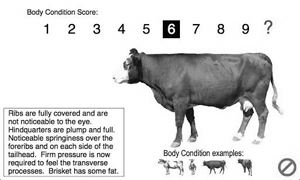|
Fall Calving Approaching
ERIN LARIMORE
JACKSON, MO.
Body condition of cows and heifers at calving impacts incidence of dystocia, colostrum quality, and return to estrus or post-partum interval which affects rebreeding ability. Target for mature cows at calving time is a body condition score of 5 while 1st calf heifers have a target of 6. Fat cows can experience calving difficulty due to too much fat in the pelvic area where the calf will pass through during the birthing process. Thin cows can be too weak to push out their calf and also have calving problems. Thin cows have lower colostrum quality and passive immunity transferred to the calf will be lower than cows in a condition score 5 or 6. Body condition is typically lost following calving due to the high nutrient requirement for the production of milk. Because lactation is higher on the priority scale for that cow than reproduction, a thin cow will use her resources to produce milk and put reproduction on the back-burner. This can cause a slow return to estrus and you may have trouble getting her bred back in a timely manner. Minimizing the loss of body condition following calving and making sure cows/heifers are in good condition prior to calving can help reduce these negatives.
Body condition scoring (BCS) is done on a 1-9 scale with 1=emaciated and 9=obese. Cattle typically range in the 4-7 score. With a score of 5 the indicator is that you can see the last 2 or 3 ribs and a score of 6 has a smooth appearance over the ribs. Moving BCS requires from 75-125 pounds of body weight depending on the frame size of the animal.
As calving approaches it is also important to know the signs of calving and animals experiencing calving difficulty. The stages of labor, physical changes, signs of labor, and time frame for each stage is listed in the table below. Recognizing abnormal delivery can help to determine when and if to assist the cow and help to save calves and reduce post calving problems in the cow.
Recognizing abnormal delivery:
• If time from feet being visible to birth is longer than 2 hours
• No progress in a 30 minute period. ∆
ERIN LARIMORE: Livestock Specialist, University of Missouri


|
|